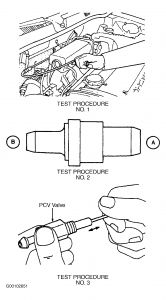POSITIVE CRANKCASE VENTILATION
The Positive Crankcase Ventilation (PCV) system uses intake manifold vacuum to eliminate crankcase pressure and recycle blow-by gasses. Manifold vacuum draws gases from crankcase, through PCV hose, into combustion chamber. The PCV valve is positioned in hose through which crankcase gases flow on their way to combustion chamber.
By opening and closing in direct relation to engine vacuum, the PCV valve meters crankcase gas flow to combustion chamber. During periods of high manifold vacuum, such as at idle and deceleration, PCV valve is almost completely closed, limiting flow of gases. During cruise speeds, PCV valve permits greatest flow of gases.
Under conditions in which excessively high amounts of crankcase pressure is produced (such as heavy load), system allows excess gases to flow back through crankcase vent hose and into intake tract.
POSITIVE CRANKCASE VENTILATION
System Inspection
Warm engine to normal operating temperature, and let it idle. Remove Positive Crankcase Ventilation (PCV) valve from cylinder head cover port. With PCV valve attached to vent hose, block PCV valve opening and check for vacuum. Seetest procedure No. 1 in Fig. 74 . If no vacuum is felt, check for blockage or collapsed vent hose, or restricted PCV valve. For vent hose problem, replace or repair as necessary. For PCV valve problem, go to next step.
For plug in type PCV valve. Note direction of valve installation. Remove PCV valve from vent hose. Blow air into port "A", verify that air comes out of port "B". Blow air into port "B", verify that no air comes out of port "A". Seetest procedure No. 2 in Fig. 74 . If problem is found, clean or replace PCV valve as necessary. For PCV valve screw-on type, go to next step.
For screw-on type PCV valve. Remove PCV valve from vent hose. From threaded side insert a thin stick into PCV valve to check if plunger moves. See test procedure No. 3 in Fig. 74 . If plunger does not move, PCV valve will be clogged. Clean or replace as necessary.
Fig. 74: Locating, Identifying & Testing PCV Valve
Courtesy of KIA MOTORS AMERICA, INC.

SPONSORED LINKS
Thursday, February 19th, 2009 AT 8:12 PM


